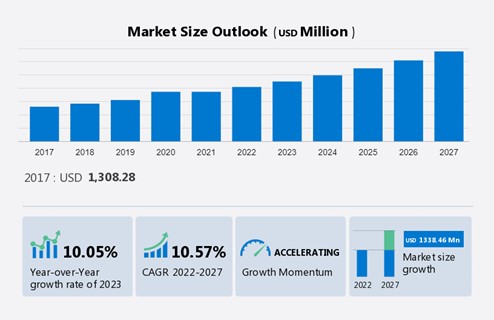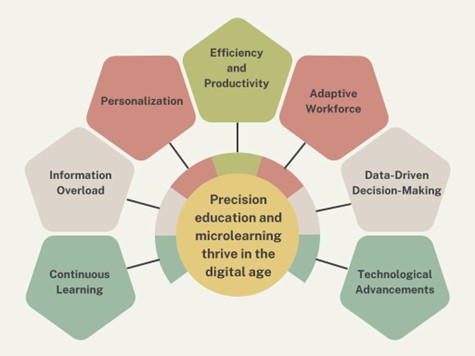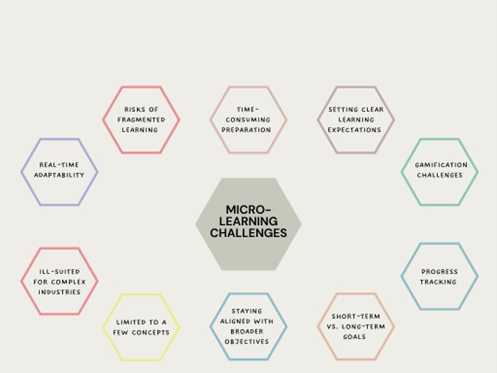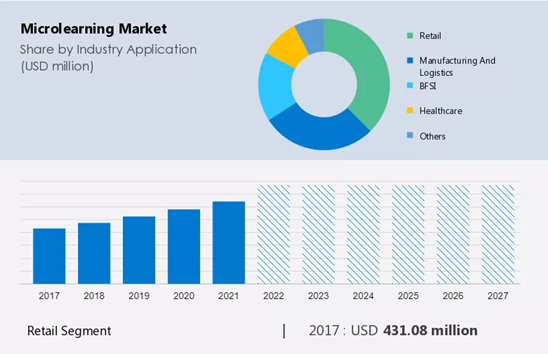
The demand for knowledge and skills has reached unprecedented levels. Traditional, one-size-fits-all training and education models are no longer sufficient to keep up with the rapid pace of change. Precision education and microlearning emerge as the answer to this pressing challenge. In a recent study, it was revealed that employees forget nearly 70% of what they learn within 24 hours of training completion. However, when educational content is delivered in bite-sized, easily digestible formats - a hallmark of microlearning - retention rates soar to a staggering 60%, according to another research. Furthermore, precision education, which tailors learning experiences to individual needs and learning styles, has been proven to enhance skill acquisition and long-term knowledge retention.
A report by McKinsey & Company found that organizations that implement personalized learning solutions are more likely to see improved performance and engagement among their employees. These statistics underscore the transformative potential of precision education and microlearning in the corporate sphere, where adaptability and continuous learning have become paramount in achieving success.
Market Relevance
Market relevance and the demand for solutions in precision education and microlearning have seen a remarkable surge in recent years, driven by the ever-evolving needs of the corporate world. In a rapidly changing business landscape, staying competitive demands a more efficient and dynamic approach to learning and skill development.

Market Size Outlook (2017-2027)
Precision education and microlearning are no longer on the fringes of corporate training and education but have become central to the strategies of forward-thinking organizations. They address the critical challenge of equipping employees with the right knowledge and skills precisely when needed, ultimately improving performance, engagement, and adaptability. This relevance is underscored by the emergence of numerous startups and tech companies specializing in microlearning platforms and precision education tools. Additionally, established educational institutions and corporations are increasingly investing in these methodologies to enhance the learning experiences of their employees and customers. Market relevance is further heightened by the adaptation of these approaches to areas such as onboarding, compliance training, and product knowledge dissemination.
Demand for Innovative Precision Education Tools
The current demand for precision education and microlearning solutions is driven by several factors:

Continuous Learning: The digital age has ushered in an era of lifelong learning. Employees and individuals are expected to continuously adapt to new information and technologies. Microlearning, with its bite-sized, on-the-go content, is perfectly suited to support this need.
Information Overload: The volume of information available is overwhelming, making it challenging to separate what is relevant from what is not. Microlearning provides a structured way to deliver only essential, task-relevant knowledge.
Personalization: Learners today expect personalized experiences. Precision education tailors content to individual learning styles and preferences, which resonates with the desire for customized learning paths.
Efficiency and Productivity: In the corporate world, time is money. Precision education and microlearning lead to more efficient learning and task performance. The demand for these solutions is driven by the desire to maximize employee productivity.
Adaptive Workforce: The rapidly changing business environment necessitates an agile and adaptive workforce. Organizations seek ways to upskill and reskill employees quickly, and microlearning facilitates just-in-time learning for immediate application.
Data-Driven Decision-Making: The ability to track and analyze learning and performance data is highly valued. Microlearning and precision education platforms often come with robust analytics, providing organizations with insights to improve training strategies.
Technological Advancements: Advancements in technology have made microlearning more accessible and engaging. From mobile learning apps to AI-powered recommendations, the tools for delivering precision education are becoming more sophisticated.
The current demand for precision education and microlearning is not just a trend but a fundamental shift in how organizations approach learning and knowledge management. In an era where knowledge is power, these solutions empower individuals and businesses to adapt and thrive in a fast-paced, information-driven world.
Current Market Landscape: Precision Education and Microlearning
Market Size and Growth Rate:
The global microlearning market is on an upward trajectory, with its value anticipated to surge from USD 2.31 billion this year to USD 4.40 billion in the next five years, marking a CAGR of 13.77%. This growth is attributed to several factors:
-
Effectiveness over Traditional Learning: Traditional methodologies, which often rely on listening, reading, and observing, result in only 20-30% content retention. In contrast, technological advancements like simulation-based microlearning ensure a significantly higher learning outcome.
-
Global Workforce Dynamics: The rise of mobile workers worldwide and the increasing demand for result-oriented, skill-based training that offers measurable corporate results have accelerated microlearning’s adoption.
-
Design and Flexibility: Microlearning delivers training in small, focused nuggets, specifically tailored to achieve distinct learning outcomes. This model is gaining traction because of its advantages for both learners and educators.
-
Cloud-Based Solutions: The growth of cloud technology has propelled the market further. These solutions provide the infrastructure necessary to overcome the scalability challenges posed by traditional on-premise microlearning platforms.
-
Adaptation and Integration: Existing platforms are incorporating microlearning techniques, utilizing tools like gamification to enhance user engagement and value creation.
-
The Freelance Economy: With millennials showing a preference for job flexibility, there’s been a surge in the freelance workforce. These individuals, frequently transitioning between roles and organizations, present a significant opportunity for microlearning providers.
-
Gamification in Training: The increasing adoption of gamified education and training mechanisms is expected to present further growth avenues for the microlearning industry.
Impact of the Pandemic
The COVID-19 pandemic unexpectedly acted as a catalyst for the microlearning market. Many industries adopted microlearning strategies during the pandemic to train their teams in new technologies and processes vital for business continuity. Using a blend of videos, audios, and expert insights, microlearning modules enabled swift skill acquisition. As a result, the pandemic not only underscored the importance of microlearning in crisis scenarios but also positioned it as a vital tool for continuous learning in the future.
Trends and Insights:
-
Mobile Learning: With the ubiquity of smartphones, there’s been a significant shift towards mobile learning. Microlearning fits seamlessly into this trend, offering short lessons that can be consumed on-the-go.
-
Adaptive Learning: Powered by AI, platforms have begun offering adaptive learning experiences, where content is tailored based on the learner’s performance and preferences.
-
Integration with AR and VR: Microlearning modules are being integrated with Augmented Reality (AR) and Virtual Reality (VR) to offer immersive learning experiences.
-
Corporate Training: Businesses increasingly recognize the advantages of microlearning for employee training. Its ability to offer quick, focused lessons makes it particularly attractive for on-the-job training and upskilling.
-
Global Expansion: With the benefits of microlearning gaining recognition, platforms have started to localize their content, catering to non-English speaking regions and diversifying their user base.
Redefining Corporate Learning by Addressing Microlearning Challenges with Innovative US Patented Solutions
Patent Excerpts
“A method for live digital streaming of one or more contextual micro-content blocks in real-time for a workflow task to facilitate task performance by a user, wherein the method comprises:
navigating through one or more digital information sources accessible over a network and searches for information that matches one or more parameters of relevance for the workflow task;
extracting computer-executable information files from the one or more digital information sources that matches the one or more parameters of relevance for the workflow task;
digitally processing the extracted computer-executable information files into a plurality of processed information blocks;
generating one or more contextual micro-content blocks from the plurality of processed information blocks; and
transmitting the one or more contextual micro-content blocks relating to the workflow task to a device associated with the user at a time when a plurality of micro-tasks of the workflow task are about to start.”
“A system for live digital streaming of one or more contextual micro-content blocks in real-time for a workflow task to facilitate task performance by a user, wherein the system comprises:
an information management server connected to a plurality of user devices associated with a plurality of users, wherein each of the user devices performs the workflow task at a particular time and location such that performance of the workflow task occurs at a location remote from a location of the information management server, and wherein the workflow task comprises a plurality of micro-tasks performed in a particular sequence at particular locations and particular time slots, wherein the information management server comprises a processor to:
navigate through a plurality of information sources distributed remotely from one another and storing digital files executable by the information management server in a plurality of respective storage devices;
monitor and receive details pertinent to the workflow task based on certain inputs received from at least one of the user devices and certain automated transfer of digital messages from the user devices; and
transmit one or more micro-content blocks to the user device based on at least one of the inputs received and the digital messages, wherein the micro-content blocks indicate the workflow task along with the respective micro-tasks and a context of the user device, user, and the performance of the workflow task.”
As microlearning continues to revolutionize corporate training, it’s crucial to recognize and address the inherent challenges it presents. Understanding these limitations is the first step towards harnessing the full potential of this transformative approach to learning. Moreover, the emergence of innovative technologies like our pioneering patented solution, “Adaptive Micro-Content Delivery for Enhanced Workflow Performance,” offers a promising path to overcoming these challenges.

1. Limited to a Few Concepts - Striking the Balance
Microlearning’s concise nature often limits its ability to delve deeply into complex topics. However, the new patented technology adopts a context-first approach to deliver bite-sized modules, ensuring the most pertinent concepts are presented without sacrificing depth.
2. Ill-suited for Complex Industries - Making Learning Digestible
In industries demanding comprehensive training, such as healthcare, microlearning may fall short. The innovative solution excels in providing contextual, task-specific information, making intricate concepts more digestible and directly applicable.
3. Engagement and Dedication - Real-time Adaptability
Microlearning’s brevity can sometimes lead to reduced learner commitment. New technology is needed to enhance engagement by providing precise, relevant content exactly when it’s needed, ensuring learners stay motivated.
4. Risks of Fragmented Learning - Coherent Learning Paths
Disconnected micro-modules can lead to fragmented learning experiences. A context-sensing engine is needed to ensure that each module remains relevant and is seamlessly aligned with the learner’s progression, creating a coherent learning journey.
5. Time-consuming Preparation - Optimized Content Creation
Creating microlessons can be time-consuming, especially when restructuring existing materials. With the adaptive content sensing capability, this process becomes more efficient, focusing on extracting contextually relevant data.
6. Setting Clear Learning Expectations - Defining Objectives
Unclear learning objectives can lead to minimalistic expectations. The adaptive technology ensures that each micro-module has well-defined learning goals, promoting comprehensive education within bite-sized lessons.
7. Gamification Challenges - Balancing Fun and Education
Gamified microlearning has its advantages but poorly designed games can be confusing or distracting. The new solution strikes a balance, ensuring that even gamified content remains informative and engaging.
8. Progress Tracking - Enhanced Monitoring
The multitude of micro-modules can complicate progress tracking. New features are required for efficient tracking, providing a clear overview for both learners and instructors.
9. Overlooking the Bigger Picture - Staying Aligned with Broader Objectives
Microlearning sometimes sidelines broader contexts. We need to address this by tailoring content to specific tasks, ensuring that learners always align with the broader learning objectives.
10. Short-term vs. Long-term Goals - Bridging the Gap
Microlearning often emphasizes short-term objectives. New technologies must ensure that content aligns with both immediate tasks and the organization’s long-term vision.
While microlearning is reshaping corporate training, challenges persist. With innovative technologies like our patented “Adaptive Micro-Content Delivery for Enhanced Workflow Performance,” we are not only addressing these challenges but also ensuring that microlearning aligns perfectly with broader, long-term objectives.
Understanding The New Patented Technology - Adaptive Micro-Content Delivery for Enhanced Workflow Performance
The new patented technology is poised to be the next revolutionary change in precision education and learning. It directly addresses theoretical problems faced by organizations today: the need for employees to rapidly acquire specific knowledge and skills tailored to their tasks, roles, and requirements while addressing the barriers and challenges mentioned above.
In an era where information overload and distracted learning can hinder productivity, this innovative patented system and method ensure that learners receive precisely what they need, when they need it, optimizing their learning experience. It aligns with the principles of microlearning, which has been demonstrated to enhance information retention and application.
The patent’s potential applications are vast, spanning across industries where precision education and efficient task performance are paramount, including on-the-job training, skill development, and knowledge transfer, compliance and security. With this innovation, corporate training and education are set to be more effective, streamlined, and in tune with the dynamic demands of modern business. It promises to significantly impact employee performance, engagement, and ultimately an organization’s success in today’s fast-paced and ever-changing market.
Key Features and Innovations
Some of the unique capabilities the patented precision education technology offers are:
Real-time Contextual Micro-Content: The patented technology offers the capability to deliver micro-content blocks in real-time, precisely when they are needed. This dynamic and context-aware approach ensures that users receive information relevant to their workflow tasks at the right moment, significantly improving their learning and performance outcomes.
Content Aggregation and Relevance Search: The patent introduces a unique process of navigating through digital information sources accessible over a network. It not only searches for information but also filters and selects data that matches predefined parameters of relevance for a specific workflow task. This feature is pivotal in ensuring that learners receive information that directly contributes to their task success.
Content Processing: The patent goes further by digitally processing the extracted information files into a series of processed information blocks. This step allows for the conversion of raw data into a format that is optimized for quick comprehension and application. It aligns with the microlearning approach, breaking down content into easily digestible components.
Contextual Micro-Content Generation: Perhaps the most innovative aspect of this patent is its ability to generate contextual micro-content blocks from the processed information. This means that learners are not only served with relevant information but are presented with it in a format that is highly conducive to quick absorption and utilization.
Precision Timing: The contextual micro-content blocks are transmitted at the precise moment when a user’s micro-tasks within a workflow are about to commence. This synchronization ensures that learners receive the necessary guidance precisely when it is most beneficial, increasing task performance efficiency and overall learning effectiveness.
One of the potential applications of this patent is a real-time content curation and delivery platform. Imagine a cutting-edge platform that redefines content curation and delivery for businesses, enhancing knowledge sharing, training, and documentation creation. This platform can leverage the key features outlined in the patent claims to offer real-time, contextually relevant micro-content, revolutionizing how organizations manage and share knowledge. The platform can include the following capabilities easily possible with the patented technology. The platform can allow real-time content aggregation and customization and be equipped with advanced algorithms that continuously scour the web and internal knowledge repositories to search for the latest information relevant to the organization’s needs. It may identify content that matches predefined parameters of relevance for specific tasks and workflows.
The patented technology can help generate real-time knowledge feeds to provide users with dynamic, real-time resources tailored to their roles and tasks. It can continuously update and suggest the most relevant information for their work.
The patented technology allows to build intuitive authoring tools. Users can also create their own micro-content blocks and documentation with ease, streamlining the content authoring process.
Consider another example of a multinational tech firm’s recruitment department grappling with the onboarding of new engineers. With a vast array of technical documentation and a need for swift task mastery, employees are inundated with information, resulting in slow ramp-up times and a high learning curve. By implementing the patented technology, the company can tailor real-time micro-content to individual engineers as they work on specific tasks. This approach can significantly reduce onboarding time, improve task performance, and elevate overall employee satisfaction. In a competitive industry where agility and rapid skill acquisition are paramount, the patent’s innovative approach is the solution the company needed to succeed.
Other Industry Applications of the Patented Technology
-
Corporate Training:
-
Immediate Relevance: Enhance employee onboarding, upskilling, and compliance training by delivering precise, real-time content tailored to immediate needs.
-
Adaptive Learning: Shape training modules dynamically based on user interaction and feedback.
-
-
eLearning Platforms:
-
Engagement Redefined: Deliver concise, task-specific content to learners instantly, dramatically increasing engagement and knowledge retention.
-
Tailored Experiences: Personalize learning paths, ensuring learners receive content relevant to their progression and interests.
-
-
Digital Marketing:
-
Real-Time Engagement: Elevate customer interactions by providing targeted, on-the-spot content designed to inform, engage, and convert.
-
Adaptive Campaigns: Modify marketing strategies in real-time based on user interactions and feedback.
-
-
Technical Documentation:
-
Instant Clarity: Provide real-time, task-specific technical insights, enhancing user understanding and reducing ambiguities.
-
Adaptable Content: Update documentation on-the-fly based on feedback, ensuring consistent clarity and relevance.
-
-
Customer Experience:
-
Frontline Excellence: Arm frontline staff with real-time, situation-specific information, driving superior customer interactions and satisfaction.
-
Personalized Interactions: Tailor customer interactions based on real-time insights, fostering brand loyalty.
-
-
Sales and Retail:
-
Informed Sales Teams: Equip teams with instantaneous product information and training, boosting sales efficacy.
-
Responsive Merchandising: Adapt in-store or online product showcases in real-time based on customer interaction data.
-
-
Workplace Safety and Compliance:
-
Safety First: Offer real-time updates on safety protocols, ensuring immediate risk mitigation.
-
Compliance Adherence: Ensure teams are always aligned with the latest regulatory requirements via real-time notifications.
-
Additional Benefits the Patented Technology Brings to Companies
Enhanced Productivity: Users can quickly access the information they need to perform tasks efficiently, reducing downtime and errors.
Continuous Learning: The platform promotes a culture of continuous learning, ensuring that employees are always up-to-date with the latest information and best practices.
Improved Knowledge Management: Organizations can harness the power of their collective knowledge, turning it into a valuable asset.
Reduced Training Costs: With just-in-time learning, organizations can reduce the time and resources required for formal training programs.
Applications across numerous industries
The patented technology for live digital streaming of contextual micro-content blocks in real-time has versatile applications across numerous industries. Here are some sectors where it can find meaningful use:
1. Healthcare:
In healthcare, the patent can be applied to deliver real-time medical guidelines, patient data, and diagnostic information to healthcare professionals during surgeries or patient consultations, improving decision-making and patient care.
2. Manufacturing:
Within manufacturing, the technology can streamline training for factory workers, providing task-specific instructions and safety information in real-time as they work on the production line, thereby enhancing productivity and reducing errors.
3. Education:
Educational institutions can use this method for personalized learning experiences, offering students on-the-fly educational resources that align with their current coursework or projects, enhancing the learning process.
4. Finance:
In the financial sector, the patent can be utilized to provide real-time market data, financial news, and investment advice to traders and financial analysts, helping them make informed decisions.
5. Customer Support:
Customer support centers can use this technology to equip agents with relevant customer information and issue-specific solutions in real-time, significantly improving customer service efficiency and satisfaction.
6. Information Technology:
In IT departments, the method can offer real-time solutions for technical support teams, enabling them to access troubleshooting guides and updates precisely when needed.
7. Retail:
Retail businesses can provide store associates with real-time product information, inventory updates, and pricing details, enhancing customer service and sales.
8. Transportation:
In the transportation industry, the technology can improve the training of pilots, train operators, or drivers, offering task-specific instructions and real-time data to enhance safety and performance.
9. Legal Services:
Law firms can utilize this method to deliver legal research and case-specific information to attorneys and paralegals in real-time, improving case preparation and client service.
10. Research and Development:
Research and development teams across industries can receive real-time access to scientific data, patent information, and market research, enhancing innovation and product development processes.
The patented method’s adaptability to various sectors underscores its potential to transform the way professionals receive and utilize information, thereby boosting task performance, reducing errors, and enhancing productivity across a wide spectrum of industries.
11. Security and compliance:
Micro content can provide immediate, on-the-job guidance to employees. For example, if an employee is about to send a sensitive document, a checklist can remind them to double-check the recipient list, apply encryption, and add required disclaimers.By analyzing an employee’s current task and the data they are handling, micro content can deliver personalized recommendations. For instance, when an employee is processing financial data, it can suggest specific security protocols or compliance measures.
Micro content can be a part of ongoing training. It can remind employees of best practices and compliance guidelines during their daily workflow, ensuring that training is not a one-time event but a continuous process.
Checklists in micro content can help reduce human error by ensuring that employees don’t forget critical steps in security or compliance procedures. This is especially important in highly regulated industries.
Contextual micro content can raise awareness about emerging threats or changes in compliance regulations. For example, if there’s a new data privacy law, employees can receive instant updates and instructions on how to adapt their workflow. If an employee encounters a security or compliance issue, micro content can offer quick solutions or links to relevant resources, preventing problems from escalating.
Micro content can prompt employees to maintain proper documentation and records as required for compliance. For example, when an employee completes a task, a checklist item can remind them to save relevant records in a designated location.
By monitoring interactions with micro content, organizations can track employee adherence to security and compliance procedures. This data can be used for performance evaluations, identifying areas for improvement, and auditing.
Employees can provide feedback on the usefulness of micro content. If something isn’t helpful or needs improvement, this feedback can be used to refine the content and make it more effective. Micro content can be seamlessly integrated into the tools employees use daily, such as email clients, document editors, or project management platforms. This ensures that the guidance is readily accessible during work.
During security incidents or compliance breaches, micro content can guide employees on the immediate steps to take to mitigate risks and ensure regulatory reporting compliance.
Why Embrace This Innovation?
-
Scalability: The technology’s application breadth demonstrates its adaptability across diverse industries, from eLearning to retail.
-
Absolute Relevance: Ensure users always receive the most pertinent, real-time content, optimizing efficiency and engagement.
-
Future-Proof: The integration capabilities of this method with emerging technologies ensure its relevance in the evolving digital age.
-
User-Centricity: With a focus on delivering task-specific content instantly, the user remains at the center of every interaction.
For organizations looking to be at the forefront of user engagement and efficiency, this patented method provides a transformative solution. Harness its power to redefine your industry standards in content delivery and user experience.

